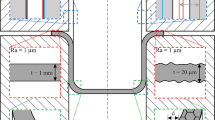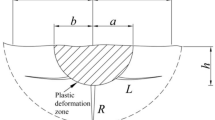Abstract
Since the structured dimple surface is one of the important functional drag-reducing surfaces, the research on its efficient fabrication technology is of great significance for the practical application of this surface. Therefore, in order to grind structured dimple surface, a topological mapping grinding method for structured dimple surface was proposed based on grinding kinematics principle and point set topology. Firstly, the topological spaces of the workpiece and the grinding wheel were established, and the topological features of the structured dimple surface and the structured grinding wheel were extracted based on the analysis of the topography features of the structured surface with ordered pattern. Then, the topology mapping equation of the grinding process was constructed based on the analysis of the generating mechanism of the dimple surface about grinding geometry, and the structured grinding wheel was designed according to the topology mapping equation. Finally, according to the grinding geometry simulation, the influence of grinding parameters on the generating of dimple surface topography was studied, and the grinding experiment was carried out. The results show that the structured grinding wheel designed based on the topological features of the structured dimple surface can achieve the grinding of the structured dimple surface. The ground dimple surface is a topological dimple surface, and its feature parameters can be changed with the change of grinding parameters, but the topological feature attributes remain unchanged under the condition of satisfying the proper grinding speed ratio.

















Similar content being viewed by others
Availability of data and material
All data generated or analyzed during this study are included in this published article.
Code availability
Not applicable.
References
Evans CJ, Bryan JB (1999) “Structured”, “textured” or “engineered” surfaces. CIRP Ann Manuf Technol 48(2):541–556
Malshe AP, Bapat S, Rajurkar KP, Haitjema H (2018) Bio-inspired textures for functional applications. CIRP Ann Manuf Technol 67(2):627–650
Han ZW, Mu ZZ, Yin W (2016) Biomimetic multifunctional surfaces inspired from animals. Adv Coll Interface Sci 234:27–50
Liu KS, Lei J (2011) Bio-inspired design of multiscale structures for function integration. Nano Today 6:155–175
Yu CM, Liu MF, Zhang CH, Yan H, Zhang MH, Wu QH, Liu MJ, Jiang L (2020) Bio-inspired drag reduction: from nature organisms to artificial functional. Giant 2(100017):1–12
Luo YH, Yuan L, Li JH, Wang JS (2015) Boundary layer drag reduction research hypotheses derived from bio-inspired surface recent advanced applications. Micron 79:59–73
Ibatan T, Uddin MS, Chodhury MAK (2015) Recent development on surface texturing in enhancing tribological performance of bearing sliders. Surf Coat Technol 272:102–120
Liu XM, Zhao DC, Chen L, Luo LH (2019) Biomimetic biological tribology development status and application prospect. Chinese Journal of Construction Machinery 017(002):95–101
Brinksmeier E, Karpuschewski B, Yan J, Schönemann L (2020) Manufacturing of multiscale structure surface. CIRP Ann Manuf Technol 69(2):717–739
Hirt G, Thome M (2008) Rolling of functional metallic surface structures. CIRP Ann Manuf Technol 57:317–320
Schneider YG (1984) Formation of surfaces with uniform micro-patterns on precision machine and instruments parts. Precis Eng 6(4):219–225
Bai LJ, Zhang JH, Tao GC, Chen XH, Wang JJ ( 2016 ) Vibration assisted milling for bionic surface manufacturing. China Mechanical Engineering 27(009):1229–1233,1242
Wang XZ, Duan J, Jiang M, Ke SH, Wu BY, Zeng XY (2017) Study of laser precision ablating texture patterns on large-scale freeform surface. Int J Adv Manuf Technol 92:4571–4581
Saito Y, Okamoto S, Miki A, Inomata H, Hidaka T, Kasai H (2008) Fabrication of micro-structure on glass surface using micro-indentation and wet etching process. Appl Surf Sci 254(22):7243–7249
Stepień P (1989) Generation of regular patterns on ground surfaces. CIRP Ann Manuf Technol 38(1):561–566
Stepień P (2007) Grinding forces in regular surface texture generation. Int J Mach Tools Manuf 47:2098–2110
Stepień P (2008) Mechanism of grinding wheel surface reproduction in regular surface texture generation. Surf Eng 24(3):219–225
Stepień P (2009) Regular surface texture generated by special grinding process. J Manuf Sci Eng 131(1):011015–1011015–7
Stepień P (2011) Deterministic and stochastic components of regular surface texture generated by a special grinding process. Wear 271:514–518
Islam MM, Kim HC, Ko TJ (2016) Formulating CAM parameters for surface patterning by grinding process based on unit pattern geometry. Int J Adv Manuf Technol 83:595–609
Kim HC, Ko TJ (2014) Simulation of micro-patterns engraved by grinding process with screw shaped wheel. Simul Model Pract Theory 49:277–286
Kim HC, Ko TJ (2015) Verification of simulation of surface texturing on planar surface by grinding. Int J Precis Eng Manuf 16(2):225–231
Cao HY, Chen X, Li HL (2018) Dressing strategy and grinding control for cylindrical microstructural surface. Int J Adv Manuf Technol 99:707–727
Liu YM, Gong S, Li JY, Cao JG (2017) Effects of dressed wheel topography on patterned surface textures and grinding force. Int J Adv Manuf Technol 93:1751–1760
Mohamed ALM, Warkentin A, Bauer R (2017) A Prediction of workpiece surface texture using circumferentially grooved grinding wheels. Int J Adv Manuf Technol 89:1149–1160
Oliveira JFG, Bottene AC, Franc TV (2010) A novel dressing technique for texturing of ground surfaces. CIRP Ann Manuf Technol 59:361–364
Silva EJ, Oliveira JFG, Salles BB, Cardoso RS, Reis VRA (2013) Strategies for production of parts textured by grinding using patterned wheels. CIRP Ann Manuf Technol 62(1):355–358
Silva EJ, Bottene AC, Oliveira JFG (2016) Grinding process for profiled texturing. CIRP Ann Manuf Technol 65(1):337–340
Silva EJ, Kirsch B, Bottene AC, Simon A, Aurich JC, Oliveira JFG (2016) Manufacturing of structured surfaces via grinding. J Mater Process Technol 243:170–183
Moreno MG, Ruiz JÁ, Azpeitia DB, González JIM, Fernández LG (2020) Friction improvement via grinding wheel texturing by dressing. Int J Adv Manuf Technol 107:4939–4954
Denkena B, Köhler J, Wang B (2010) Manufacturing of functional riblet structures by profile grinding. CIRP J Manuf Sci Technol 3(1):14–26
Denkena B, Köhler J, Wang B (2010) Advanced microstructures and its production through cutting and grinding. CIRP Ann Manuf Technol 59(1):67–72
Denkena B, Leon LD, Wang B (2009) Grinding of microstructured functional surfaces: a novel strategy for dressing of microprofiles. Production Engineering Research and Development 3(1):41–48
Denkena B, Grove T, Krawczyk T (2016) Tools and strategies for grinding of riblets on freeformed compressor blades. Procedia CIRP 55:182–187
Xie J, Luo MJ, He JL, Liu XR, Tan TW (2012) Micro-grinding of micro-groove array on tool rake surface for dry cutting of titanium alloy. Int J Precis Eng Manuf 13:1845–1862
Xie J, Li P, Wu KK, Pei XB, Liu YJ, Xie HF (2013) Micro and precision grinding technique and functional behavior development of micro-structured surface. Journal of Mechanical Engineering 49(23):182–190
Wu MT, Guo B, Zhao QL, Zhang J, Fang XY, He P (2019) High efficiency precision grinding of micro-structured SiC surface using laser micro-structured coarse-grain diamond grinding wheel. International Journal of Precision Engineering and Manufacturing-Green Technology 6:577–586
Li HN, Axinte D (2016) Textured grinding wheels: a review. Int J Mach Tools Manuf 109:8–35
Monier A, Guo B, Zhao QL, Liu WC (2021) Strategy and error analysis for machining the designed micro structured surfaces by structured grinding wheels. Int J Adv Manuf Technol 113:1361–1376
Xu SL, Point Set Topology, Higher Education Press, July 1, 2007
Galda L, Dzierwa A, Sep J, Pawlus P (2010) The effect of oil pockets shape and arrangement on seizure resistance in lubricated sliding. Tribol Lett 37:301–311
Nakano M, Korenaga A, Korenaga A, Miyake K, Murakami T, Ando Y, Usami H, Sasaki S (2007) Applying micro-texture to cast iron surfaces to reduce the friction coefficient under lubricated conditions. Tribol Lett 28:131–137
Li K, Yao Z, Hu Y, Gu W (2014) Friction and wear performance of laser peen textured surface under starved lubrication. Tribol Int 77:97–105
Iterson GV, Mathematische und mikroskopisc-anatomische Studien über Blattstellungen nebst Betrachtungen über den Schalenbau der Miliolin.1907
Lyu YS, Liu YM, Li XS, Di HX, Wang H (2021) A strategy on generating structured plateau surface by the sinusoidal oscillatory lapping of the grinding wheel with the phyllotactic pattern of abrasive grains. J Manuf Process 65:435–444
Ren JS, Principles of grinding, Publishing House of Electronics Industry, January 1, 2011
Liu ZZ, Wang J, Lu YS, Ma F (2014) Fabrication of the electroplated CBN wheel for cylindrical grinding with abrasive phyllotactic pattern. Advanced Materials Research 1077:44–49
Shi Z, Malkin S (2006) Wear of Electroplated CBN Grinding Wheels. Transactions of the ASME. J Manuf Sci Eng 128:110–118
Yu HY, Wang J, Lu YS (2016) Modeling and analysis of dynamic cutting points density of the grinding wheel with an abrasive phyllotactic pattern. Int J Adv Manuf Technol 86:1933–1943
Funding
The authors gratefully acknowledge the support for this work from Chinese National Natural Science Foundation (no. 51875368).
Author information
Authors and Affiliations
Contributions
Author 1 (first author): conceptualization, methodology, software, investigation, formal analysis, writing—original draft, Author 2: data curation, Author 3: visualization, investigation, Author 4: resources, writing—original draft.
Corresponding author
Ethics declarations
Ethics approval
Not applicable.
Consent to participate
Not applicable.
Consent for publication
Not applicable.
Competing interests
The authors declare no competing interests.
Additional information
Publisher's Note
Springer Nature remains neutral with regard to jurisdictional claims in published maps and institutional affiliations.
Rights and permissions
About this article
Cite this article
Yushan, L., Guoxun, W., Xingshan, L. et al. Research on the mapping grinding of dimple surface with ordered pattern based on topological theory. Int J Adv Manuf Technol 121, 6205–6223 (2022). https://doi.org/10.1007/s00170-022-09711-1
Received:
Accepted:
Published:
Issue Date:
DOI: https://doi.org/10.1007/s00170-022-09711-1




